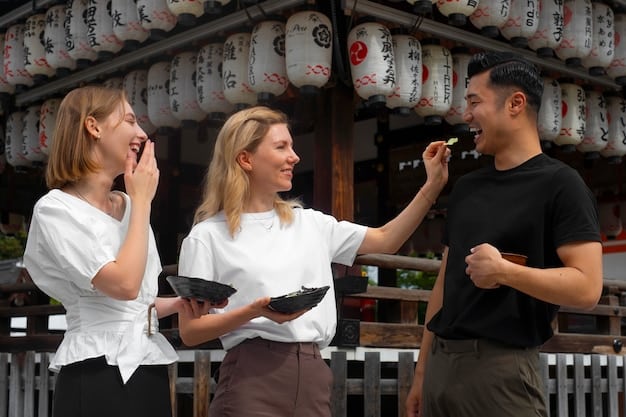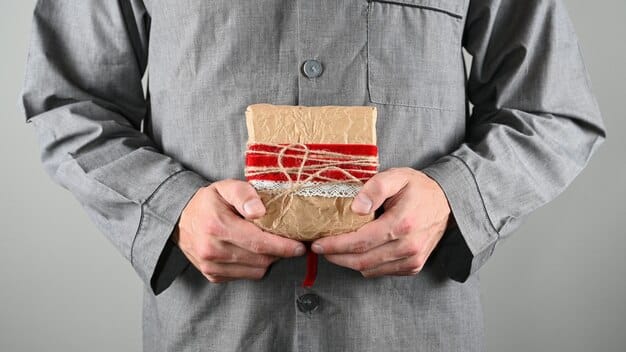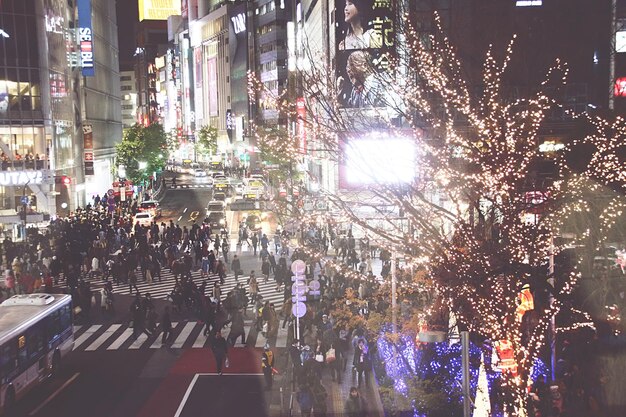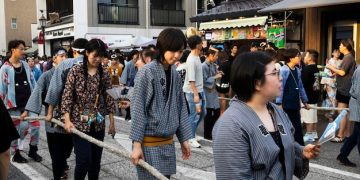Mastering Japanese Bargaining: A US Shopper’s Guide

Navigating the nuances of pricing in Japan as a US shopper requires understanding the cultural context; while direct haggling is uncommon, polite inquiry and embracing a non-confrontational approach can occasionally yield favorable outcomes in specific retail settings.
For many US shoppers, the idea of negotiation, or “bargaining,” is a familiar part of the retail experience. However, when traveling to Japan, this practice undergoes a significant cultural shift. Mastering Japanese bargaining: A US Shopper’s Guide to Negotiating Prices Respectfully isn’t about traditional haggling, but rather understanding a subtle dance of politeness, respect, and knowing where (and when) to consider a gentle inquiry about price.
The cultural landscape of Japanese retail
Japan’s retail environment is steeped in centuries of cultural norms that prioritize harmony, respect, and meticulous service. Unlike many Western or other Asian cultures, direct confrontation, including overt haggling over prices, is generally frowned upon and can be perceived as disrespectful or even rude. The prevailing philosophy is one of offering a fair, fixed price from the outset, ensuring transparency and minimizing potential conflict.
This approach stems from deeply ingrained values such as omotenashi (wholehearted hospitality) and wa (harmony). Sellers aim to provide a pristine product or service at an honest price, and buyers are expected to accept this price as a reflection of its quality and the care taken in its provision. Deviating from this can disrupt the delicate balance of the transaction and impact the seller’s perception of their own integrity and the customer’s appreciation for their efforts.
Understanding the fixed-price mindset
The vast majority of retail establishments in Japan operate on a fixed-price system. This includes department stores, chain supermarkets, convenience stores, and even many independent boutiques and electronics retailers. Prices displayed are typically non-negotiable, and attempting to bargain in these settings can lead to awkwardness or confusion. Staff are often trained to provide excellent service within this framework, focusing on product knowledge and customer satisfaction rather than price adjustments.
- Department Stores: Luxury items and high-quality goods are sold at their listed prices, reflecting brand value and service.
- Chain Stores: Uniform pricing across locations is standard, ensuring fairness and efficiency.
- Supermarkets/Convenience Stores: Everyday essentials and food items have clear, non-negotiable prices.
- Restaurants/Cafes: Menu prices are always final, and tipping or negotiating is not customary.
Where subtle inquiry might (rarely) be possible
While the fixed-price rule is widespread, there are extremely limited and specific scenarios where a polite inquiry about price might be conceivable, though it rarely leads to a reduction comparable to Western bargaining. These are usually in very niche, traditional settings or for very high-value items, and the approach must always be one of respectful query rather than aggressive demand. This requires cultural sensitivity and an understanding that “no” is a perfectly acceptable answer.
In most contexts, the price you see is the price you pay. This predictability is often appreciated by both locals and visitors alike, simplifying transactions and removing the stress of haggling. Approaching Japanese retail with this understanding will enhance your shopping experience and ensure you maintain good cultural etiquette throughout your visit.
Navigating the Japanese retail landscape means embracing a different philosophy. It’s a space where trust in the stated price and polite interaction supersede Western-style price negotiation, ensuring a smooth and respectful exchange for both buyer and seller.
Decoding Japanese customer service and price integrity
Japanese customer service, known as omotenashi, is legendary worldwide, embodying a deep commitment to anticipating and fulfilling customer needs without expectation of reward. This philosophy extends directly into price setting. Every item, from a humble souvenir to a high-tech gadget, is priced with meticulous consideration for its quality, craftsmanship, and the labor involved in its production and sale. The price isn’t merely a number; it’s a reflection of the integrity of the product and the service provided.
The value of transparent pricing
In Japan, transparent, fixed pricing is viewed as a sign of honesty and fairness. It eliminates the need for negotiation, which can be seen as an adversarial process that undermines trust. When a shop sets a price, they stand by it, implying that it is the best possible value they can offer while maintaining their standards of quality and service. This commitment to price integrity ensures that all customers are treated equally, fostering a sense of fairness that is deeply valued in Japanese society.
This approach to pricing removes the uncertainty. You know exactly what you’ll pay, and there’s no pressure to “win” a deal. It simplifies transactions and allows shoppers to focus on the product itself, its quality, and its suitability, rather than on the potential for a lower price. This straightforwardness is a cornerstone of the Japanese retail experience, reflecting a cultural preference for clarity over complexity in commercial interactions.
Omotenashi and its role in retail interactions
Omotenashi means “to wholeheartedly look after guests”. In a retail context, this translates to attentiveness, politeness, and a commitment to providing an exceptional shopping experience. It’s about anticipating needs, offering beautifully wrapped purchases, and conducting transactions efficiently and courteously. This high level of service is considered part of the value embedded in the product’s price; it’s not something to be bargained for.
- Attentive Staff: Sales associates are focused on providing information and assistance, not on price haggling.
- Immaculate Presentation: Products are often meticulously displayed and packaged, adding to their perceived value.
- Post-Purchase Service: Emphasis on customer satisfaction, even after the sale is complete.
- Politeness and Respect: Every interaction is conducted with a high degree of courtesy and mutual respect.
Understanding the deep roots of omotenashi and price integrity is crucial for any US shopper in Japan. It reframes the shopping experience from a potential negotiation to an appreciation of quality, service, and cultural norms. Embracing this mindset will not only make your shopping more enjoyable but also ensure you respect the local customs and the efforts of Japanese retailers.
Ultimately, Japanese retail prioritizes a dignified exchange where value is intrinsic, and aggressive bargaining finds no place. This system upholds the integrity of both the seller and the product, creating a harmonious shopping environment.
Situations where a polite inquiry might be considered (rare exceptions)
While the hard and fast rule in Japan is “no bargaining,” there are extremely limited, specific contexts where a very polite, gentle inquiry about price might be made. This is absolutely not a general invitation to haggle, but rather an understanding of cultural nuances in particular settings. It requires an advanced degree of sensitivity and readiness to accept “no” gracefully. These situations are exceptions, not the norm, and any form of aggressive or persistent bargaining is still highly inappropriate and will likely cause discomfort.
Antiquarian shops and flea markets
In highly traditional and specialized settings, such as small antique shops (kotto-ya) or pre-owned goods stores, there might be a minuscule window for a subtle price inquiry, especially for higher-value items. This is less about bargaining and more about the historical context of these items or establishing a rapport with the shop owner. Even here, it’s not a given expectation. Similarly, at some local flea markets (nomi no ichi), where vendors might be individuals selling personal items, a very polite request for a slightly lower price on a large purchase might be met with consideration, but it’s rare. The key is “polite” and “inquiry,” not “demand.”
When in these environments, observe first. See how other customers interact. If you consider making an inquiry, it should involve words like “Is this the final price?” (これは最終価格ですか? – Kore wa saishū kakaku desu ka?) or “Is there any room for a slight discount?” (少し安くできますか? – Sukoshi yasuku dekimasu ka?), said with a humble tone, a slight bow, and a smile. Be prepared for a definite “no,” and accept it with a polite “Okay, thank you.”
Very high-value independent art or craft galleries
For significant purchases, such as a substantial piece of artisan pottery or a large painting from an independent gallery where you’re dealing directly with the artist or patron, a conversation about payment methods or potential for a slight adjustment might arise naturally, but it’s not a negotiation in the common sense. It’s more about building a relationship and understanding the terms. This is highly situational and depends entirely on the specific gallery and item. Discounts might be offered for cash payments, or if you purchase multiple high-value items, as a gesture of appreciation, rather than as a result of direct bargaining.
- Building Rapport: Engaging in conversation about the item’s history or craftsmanship can sometimes precede a subtle inquiry.
- Non-Insulting Offer: If you inquire, it should be a marginal reduction, demonstrating respect for the artist’s work.
- Cash Payment: Occasionally, paying in cash might open a slight possibility for a small discount, as it reduces transaction fees for the seller.
- Bundle Purchases: Buying multiple expensive items could sometimes lead to a small concession, but again, this is rare and not expected.
It cannot be stressed enough: these are extreme rarities. The general rule remains strict fixed prices. Any attempt at bargaining must be couched in politeness and respect, with a full understanding that success is highly improbable and refusal should be met with grace. The integrity of the price in Japan is considered paramount.
In these niche areas, the discussion pivots from “bargaining” to a highly respectful “inquiry,” emphasizing the need for cultural awareness and humility. The overwhelming norm mandates fixed prices, making these examples rare exceptions, not common practice for the average shopper.
The art of respectful inquiry: language and etiquette
When navigating the rare instances where a polite price inquiry might be considered in Japan, the absolute key lies in the art of respectful communication. Your choice of language, tone, and body language are far more important than the actual words themselves. This is not about being assertive; it’s about being humble, appreciative, and culturally aware. Understanding the nuances of Japanese etiquette can make all the difference between a neutral interaction and an uncomfortable one.
Choosing your words carefully
Directly asking “Can I get a discount?” (割引できますか? – Waribiki dekimasu ka?) can be too blunt or imply dissatisfaction with the listed price. Instead, consider phrases that convey genuine interest and subtle inquiry. For instance:
- “Is this the final price?” (これは最終価格ですか? – Kore wa saishū kakaku desu ka?) – This is often perceived as a softer, more direct question that clarifies.
- “If I buy [multiple items], is there a slight consideration?” (もし[複数の商品]を買えば、少し考慮できますか? – Moshi [fukusū no shōhin] o kaeba, sukoshi kōryo dekimasu ka?) – This implies a larger purchase, making a minor adjustment a gesture of appreciation rather than a flat discount.
- “Is there any way to make this more affordable?” (これをもう少し手頃にすることは可能ですか? – Kore o mō sukoshi tegoronin suru koto wa kanō desu ka?) – This is a very gentle, indirect approach, almost hinting at a budget constraint rather than a desire to haggle.
Always maintain a polite and deferential tone. Avoid any hint of demanding or expecting a price change. Your goal is to inquire, not to press. Remember that Japanese conversation often relies on subtlety and implied meaning, so directness in this context can be jarring.

Body language and demeanor
Your non-verbal cues are as important as your spoken words. A respectful demeanor involves:
- A slight bow: When beginning or ending your inquiry, a small bow shows respect.
- Smiling and politeness: Maintain a kind, open, and friendly expression. Aggression or sternness will be counterproductive.
- A humble posture: Avoid standing too tall or looking too demanding.
- Listening intently: Pay close attention to the shop owner’s response. If they hesitate or seem uncomfortable, it’s a clear sign that a discount is unlikely, and you should back off immediately.
- Acceptance of “no”: If the answer is no, a prompt and cheerful “Wakarimashita, arigatou gozaimasu” (Understood, thank you very much) is essential. Do not push further. Retreat gracefully and proceed with the purchase at the stated price or decide not to buy.
This approach isn’t about saving money as much as it is about demonstrating cultural understanding. Success, if it happens, will be a minor adjustment, a gesture of goodwill, not a significant price reduction. More often than not, it will be politely declined, and gracefully accepting that outcome is crucial for maintaining respect and a positive interaction.
The essence of respectful inquiry in Japan is understanding that the interaction itself is paramount. It’s a dance of courtesy and humility, where the price is often secondary to the preservation of harmony and mutual respect. Approach every interaction with deference, and prioritize politeness above all else.
Japanese equivalent concepts: loyalty programs and seasonal sales
While direct price bargaining is an anomaly in Japan, the concept of value and cost-saving is certainly not. Rather than negotiation, Japanese retail systems offer different avenues for customers to optimize their spending through well-established practices like loyalty programs, seasonal sales, and duty-free shopping. Understanding these mechanisms is far more productive for a US shopper looking to save money than attempting to haggle.
Loyalty programs and point cards
Many Japanese retailers, especially larger chains, electronics stores, and even some smaller independent shops, operate extensive loyalty programs through point cards. These cards allow customers to accrue points with each purchase, which can then be redeemed for future discounts or specific merchandise. These points often translate to a 1% or 0.5% return on purchase, but they can accumulate quickly for frequent shoppers or on large purchases.
- Electronics Stores (e.g., Bic Camera, Yodobashi Camera): These are renowned for their robust point systems, offering significant points on purchases that can be used immediately or on subsequent visits.
- Drugstores and Supermarkets: Common for everyday purchases, helping customers save over time.
- Department Stores: Some high-end stores offer membership programs with exclusive benefits and points for loyal customers.
As a tourist, you can often sign up for these cards on the spot. While it might not yield immediate savings on a single item, it’s a form of embedded discount for those making multiple purchases or visiting frequently.
Seasonal sales and “fukubukuro” (lucky bags)
Just like in the US, Japan has distinct periods for sales (sale kakaku). These are typically:
- New Year’s Sales (hatsu-uri): The biggest shopping event of the year, often starting on January 1st or 2nd. Deep discounts are common.
- Summer Sales: Usually from late June through July, offering reductions on seasonal apparel and goods.
- Golden Week Sales: Around late April to early May, coinciding with a major public holiday period.
- End-of-Season Clearances: Occur as new collections arrive.
A unique and highly anticipated aspect of Japanese sales culture is the fukubukuro, or “lucky bag.” These are sealed bags containing a random assortment of items from a particular store, sold at a fixed price that is significantly lower than the total value of the contents. They are extremely popular during New Year’s and can offer incredible value, though what you get is a surprise. Many stores offer them, from clothing brands to food retailers and even electronics stores.

For US shoppers, focusing on these established methods of saving money aligns with Japanese retail practices and offers a practical way to manage your budget while enjoying your shopping experience. Planning your trip around these sales periods or being open to signing up for loyalty programs can offer a more rewarding and culturally appropriate way to save.
Embracing Japan’s unique retail culture means shifting focus from individual bargaining to leveraging established discount strategies. Loyalty programs, seasonal sales, and lucky bags provide authentic and respectful avenues for value, aligning perfectly with Japanese shopping norms.
Common pitfalls for US shoppers: what to avoid
For US shoppers accustomed to a different retail culture, navigating Japan’s fixed-price, service-oriented environment can present some unexpected challenges. Understanding and avoiding common pitfalls related to price negotiation and retail interaction is crucial for a smooth and respectful experience. These missteps can range from minor awkwardness to significant cultural faux pas.
Don’t push for discounts at chain stores or department stores
The most significant and common mistake is attempting to bargain in environments where it is simply not done. This includes:
- Major Department Stores: Isetan, Mitsukoshi, Takashimaya, etc. Their pricing is uniform and strictly fixed.
- Electronics Retailers: Bic Camera, Yodobashi Camera, Yamada Denki enforce fixed prices (though they have points systems).
- Convenience Stores (konbini) and Supermarkets: Prices on everyday items are non-negotiable.
- Brand Boutiques: High-end fashion or specialty stores will not offer discounts.
- Restaurants and Cafes: Attempts to reduce menu prices are unheard of and highly offensive.
Pushing for a discount in these settings will not only fail but can also cause discomfort for the sales associate, who is trained to provide service within a fixed-price model. It shows a lack of understanding of Japanese business etiquette and can be seen as disrespectful of their pricing integrity.
Avoid aggressive or persistent negotiation tactics
Even in the rare, niche scenarios where a gentle inquiry might be tolerated, aggressive or persistent negotiation is a major pitfall. Tactics common in other parts of the world, such as:
- Feigning disinterest to walk away and return later: This is unlikely to work and may be seen as manipulative.
- Making an insultingly low offer: This will cause offense and shut down any possibility of a deal.
- Comparing prices from other stores loudly: While price-matching exists in some Western stores, openly stating another store’s cheaper price to demand a match is generally not practiced or effective in Japan and can be seen as rude.
- Getting frustrated or raising your voice: This is a severe breach of etiquette and will ensure no cooperation.
- Sticking to a price: If told “no,” immediately accept it. Do not push.
The intention in Japan is to maintain harmony (wa). Any behavior that disrupts this harmony through confrontation or aggression is seen negatively. Politeness and respect are paramount in all interactions, especially commercial ones. When in doubt, assume the price is fixed and proceed respectfully. Err on the side of caution and cultural sensitivity, rather than risking offense for a negligible discount.
Understanding these potential missteps will significantly enhance a US shopper’s experience in Japan, fostering more positive interactions and a deeper appreciation for the unique rhythm of Japanese retail.
To avoid pitfalls in Japanese shopping, US consumers must shed aggressive bargaining habits and embrace the established cultural norms of fixed pricing and respectful interaction. Prioritizing politeness over price negotiation ensures a harmonious retail experience, reflecting a deeper understanding of Japanese etiquette.
Embracing the Japanese shopping experience: beyond the price
Ultimately, a rewarding shopping experience in Japan for a US shopper means shifting focus from price negotiation to embracing the unique aspects of Japanese retail culture. It’s about appreciating the meticulously crafted products, the exceptional customer service, and the aesthetic pleasure of browsing. When freed from the pressure of haggling, shopping becomes an immersive cultural activity in itself.
Appreciating quality and craftsmanship
Japanese products are renowned for their quality, attention to detail, and often, their exquisite craftsmanship. Whether it’s a piece of traditional pottery, a high-tech electronic gadget, or a beautifully packaged snack, there’s an inherent value in the item itself. The fixed price reflects not just the materials, but the skilled labor, the design process, and often, generations of expertise passed down through family businesses.
Approach your shopping with an eye for these details. Notice how goods are presented, how they are packaged, and the stories behind their creation. This appreciation for quality over a perceived “bargain” will allow you to make purchases that are truly meaningful and lasting, rather than just cheap.
The joy of omotenashi and thoughtful service
One of the most memorable aspects of shopping in Japan is the ubiquitous omotenashi. Experience the genuine politeness, the patient assistance, and the meticulous care taken by sales staff. They are there to serve you, to help you find what you need, and to ensure your experience is comfortable and pleasant.
This level of service is a significant part of the value proposition. It means no pushy sales tactics, no pressure, and always a respectful interaction. Enjoy the beautifully wrapped purchases, the polite bows, and the readiness of staff to go the extra mile. This thoughtful service is a gift in itself and contributes significantly to the overall satisfaction of your shopping expedition.
Cultural immersion through retail
Shopping in Japan is more than just buying things; it’s a deep dive into daily life and cultural norms. From the bustling energy of Tokyo’s shopping districts to the serene atmosphere of a Kyoto craft shop, each retail environment offers a unique glimpse into Japanese society. Observe the locals, learn a few polite Japanese phrases (like arigato gozaimasu – thank you very much), and engage respectfully with shopkeepers.
- Explore diverse shops: Visit everything from modern department stores to traditional artisan workshops.
- Observe local customs: Pay attention to queueing, handling cash, and polite interactions.
- Engage respectfully: A smile and a “thank you” go a long way.
- Seek unique items: Look for products that are distinctly Japanese and not easily found elsewhere.
By letting go of the need to bargain and instead embracing the inherent quality, service, and cultural richness of Japanese retail, US shoppers can transform their experience from a transactional one into a truly enriching and enjoyable part of their journey. It’s about respecting the system that values harmony, quality, and mutual dignity above all else.
Ultimately, Japanese shopping excels beyond mere transactions, offering US shoppers a chance to immerse themselves in a culture valuing quality, impeccable service, and harmonious interactions. Letting go of the bargaining mindset allows for a richer, more respectful experience, appreciating the true essence of omotenashi.
| Key Point | Brief Description |
|---|---|
| 🇯🇵 Fixed Prices | Most Japanese retail runs on fixed, non-negotiable prices, valuing transparency and fairness. |
| 🕊️ Respectful Inquiry | Avoid direct haggling; subtle, polite inquiry in rare niche shops is the most you can do. Expect “no.” |
| ✨ Omotenashi Service | Embrace the high-quality, wholehearted hospitality as part of the total value, rather than seeking price reductions. |
| 🛍️ Sales & Points | Look for seasonal sales (hatsu-uri), lucky bags (fukubukuro), and loyalty point cards for savings. |
Frequently Asked Questions about Bargaining in Japan
No, bargaining is generally very uncommon and not expected in almost all retail settings in Japan. Most stores, from department stores to convenience stores, operate on a fixed-price system, where the listed price is the final price. Attempting to haggle can be seen as disrespectful.
Extremely rare exceptions might include small, independent antique shops, specialized pre-owned goods stores, or some local flea markets, especially for high-value items or multiple purchases. Even then, it must be a very subtle, polite inquiry, not aggressive haggling, and a “no” should be accepted gracefully without persistence.
Omotenashi, or wholehearted hospitality, means sellers offer products at a fair, considered price that includes the value of exceptional service and quality. This philosophy supports fixed pricing, ensuring fairness and transparency, and discourages bargaining, which can be seen as undermining the integrity of the product and service.
Instead of bargaining, focus on loyalty point programs offered by many stores, take advantage of seasonal sales (like New Year’s or summer sales), or try your luck with “fukubukuro” (lucky bags) which offer discounted assortments of items. Duty-free shopping for tourists is also available in many locations.
Use a very polite, humble tone, possibly a slight bow, and always a smile. Avoid any demanding or frustrated demeanor. Be ready to accept “no” immediately and gracefully, saying “Wakarimashita, arigatou gozaimasu” (Understood, thank you very much). Politeness and respect are paramount above all else.
Conclusion
For US shoppers heading to Japan, understanding the cultural nuances of commerce is key to an enjoyable and respectful retail experience. While the concept of bargaining is ingrained in many Western cultures, Japan operates on a foundation of fixed pricing, transparency, and unparalleled customer service guided by omotenashi. Embracing this approach, rather than attempting to haggle, ensures harmonious interactions and allows for a deeper appreciation of the quality and care embedded in Japanese goods and services.





